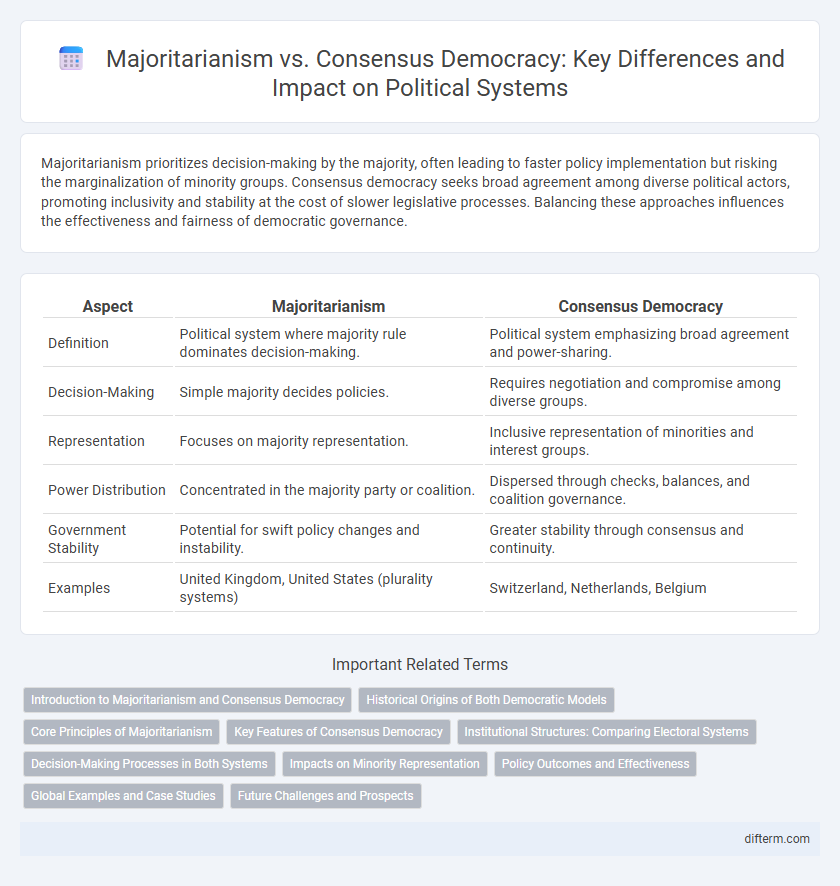Majoritarianism prioritizes decision-making by the majority, often leading to faster policy implementation but risking the marginalization of minority groups. Consensus democracy seeks broad agreement among diverse political actors, promoting inclusivity and stability at the cost of slower legislative processes. Balancing these approaches influences the effectiveness and fairness of democratic governance.
Table of Comparison
| Aspect | Majoritarianism | Consensus Democracy |
|---|---|---|
| Definition | Political system where majority rule dominates decision-making. | Political system emphasizing broad agreement and power-sharing. |
| Decision-Making | Simple majority decides policies. | Requires negotiation and compromise among diverse groups. |
| Representation | Focuses on majority representation. | Inclusive representation of minorities and interest groups. |
| Power Distribution | Concentrated in the majority party or coalition. | Dispersed through checks, balances, and coalition governance. |
| Government Stability | Potential for swift policy changes and instability. | Greater stability through consensus and continuity. |
| Examples | United Kingdom, United States (plurality systems) | Switzerland, Netherlands, Belgium |
Introduction to Majoritarianism and Consensus Democracy
Majoritarianism emphasizes decision-making by the majority, typically through simple majority rule, ensuring clear winners in elections and legislative processes. Consensus democracy prioritizes broad agreement and power-sharing among diverse groups, promoting inclusive governance and minority representation. These contrasting approaches shape democratic institutions, electoral systems, and policy outcomes worldwide.
Historical Origins of Both Democratic Models
Majoritarianism roots trace back to classical Athens, emphasizing rule by the numerical majority to ensure decisive governance, while consensus democracy developed in post-World War II Western Europe, particularly in countries like the Netherlands and Switzerland, aiming to balance diverse interests through inclusive decision-making. The historical evolution of majoritarianism reflects the English Westminster system prioritizing single-party dominance and stable government, whereas consensus democracy emerged to prevent ethnic conflict and political fragmentation within multiparty coalitions. These origins shape contemporary democratic practices, influencing institutional design and electoral systems tailored to either majority control or broad-based agreement.
Core Principles of Majoritarianism
Majoritarianism centers on the principle that the majority's decision holds supreme authority, emphasizing the rule of the majority in legislative and electoral processes. It advocates for single-party dominance, often through plurality voting systems that prioritize clear and decisive outcomes. This model prioritizes efficient governance and direct accountability, with limited negotiation or power-sharing among minority groups.
Key Features of Consensus Democracy
Consensus democracy emphasizes power-sharing, minority rights protection, and broad coalition governance to create inclusive decision-making processes. It typically includes proportional representation electoral systems, multiple veto points, and decentralization of authority, ensuring diverse interests are represented. This model fosters political stability by encouraging compromise and preventing dominance by a single party or group.
Institutional Structures: Comparing Electoral Systems
Majoritarianism relies on plurality or majority electoral systems that often produce single-party governments, emphasizing decisive outcomes and accountability. Consensus democracy employs proportional representation electoral systems aiming to include diverse political parties in government, thus fostering broader representation and coalition-building. Institutional structures in majoritarian systems tend to centralize power, whereas consensus systems distribute power more evenly across multiple parties and branches.
Decision-Making Processes in Both Systems
Majoritarianism emphasizes decision-making through majority rule, where policies are enacted by the party or coalition holding the most seats, often resulting in swift and decisive outcomes. Consensus democracy requires broad agreement among diverse political actors, fostering inclusive deliberation and power-sharing to ensure minority voices influence legislation. This collaborative approach in consensus systems tends to produce more stable and widely accepted decisions, albeit at a slower, more negotiated pace.
Impacts on Minority Representation
Majoritarianism often leads to the dominance of the largest political group, frequently marginalizing minority voices and reducing their legislative influence. In contrast, consensus democracy fosters inclusive decision-making processes, ensuring proportional representation and enhanced protection of minority interests. Empirical studies show that consensus systems correlate with higher minority participation in policymaking and better safeguarding of minority rights.
Policy Outcomes and Effectiveness
Majoritarianism often leads to swift policy outcomes due to concentrated power enabling decisive action, but it may sacrifice inclusivity and minority interests. Consensus democracy promotes broader agreement and policy stability by involving multiple parties, enhancing legitimacy and long-term effectiveness. Empirical studies show consensus systems typically produce more durable and comprehensive policies, although sometimes at the cost of slower decision-making.
Global Examples and Case Studies
Majoritarianism, exemplified by the United Kingdom's first-past-the-post system, often leads to single-party dominance and straightforward policy-making but risks marginalizing minority voices. Consensus democracy, seen in countries like Switzerland and Belgium, promotes power-sharing through coalition governments, ensuring broader representation and stability in divided societies. Comparative case studies reveal that while majoritarianism suits homogenous societies, consensus models better address pluralism by institutionalizing inclusivity and negotiated decision-making.
Future Challenges and Prospects
Majoritarianism faces future challenges in maintaining political stability amid growing societal polarization and diverse interest representation, which may undermine inclusive governance. Consensus democracy offers prospects for fostering broader cooperation and legitimacy by incorporating multiple viewpoints, but it must address the risks of decision-making gridlock and inefficiency. Adapting institutional designs to balance decisiveness and inclusiveness will be crucial for both models to effectively navigate evolving political landscapes.
majoritarianism vs consensus democracy Infographic

 difterm.com
difterm.com